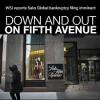
Breaking News
 If You Grew Up In The 1970s, You Probably Possess These Rare Traits
If You Grew Up In The 1970s, You Probably Possess These Rare Traits
 EVEN More SUPER SHADY Financial Dealings At TPUSA!
EVEN More SUPER SHADY Financial Dealings At TPUSA!
 British woman warns American about the Rise of Islam...
British woman warns American about the Rise of Islam...
 Saks Global prepares for bankruptcy after missing debt payment, WSJ reports
Saks Global prepares for bankruptcy after missing debt payment, WSJ reports
Top Tech News
 Laser weapons go mobile on US Army small vehicles
Laser weapons go mobile on US Army small vehicles
 EngineAI T800: Born to Disrupt! #EngineAI #robotics #newtechnology #newproduct
EngineAI T800: Born to Disrupt! #EngineAI #robotics #newtechnology #newproduct
 This Silicon Anode Breakthrough Could Mark A Turning Point For EV Batteries [Update]
This Silicon Anode Breakthrough Could Mark A Turning Point For EV Batteries [Update]
 Travel gadget promises to dry and iron your clothes – totally hands-free
Travel gadget promises to dry and iron your clothes – totally hands-free
 Perfect Aircrete, Kitchen Ingredients.
Perfect Aircrete, Kitchen Ingredients.
 Futuristic pixel-raising display lets you feel what's onscreen
Futuristic pixel-raising display lets you feel what's onscreen
 Cutting-Edge Facility Generates Pure Water and Hydrogen Fuel from Seawater for Mere Pennies
Cutting-Edge Facility Generates Pure Water and Hydrogen Fuel from Seawater for Mere Pennies
 This tiny dev board is packed with features for ambitious makers
This tiny dev board is packed with features for ambitious makers
 Scientists Discover Gel to Regrow Tooth Enamel
Scientists Discover Gel to Regrow Tooth Enamel
 Vitamin C and Dandelion Root Killing Cancer Cells -- as Former CDC Director Calls for COVID-19...
Vitamin C and Dandelion Root Killing Cancer Cells -- as Former CDC Director Calls for COVID-19...
Move over, fog nets – fog harp is better at drawing water from the air

Now, researchers from Virginia Tech have improved on the concept, creating a "fog harp" that increases the collection capacity by threefold.
A conventional fog net consists of a mesh of vertical and horizontal wires, which the droplets cling to as fog passes through. Once enough of those droplets have accumulated on the mesh, gravity causes the collected water to trickle down the vertical wires, into a trough at the bottom.
If the gaps in the mesh are too large, many droplets will pass through it without being caught. If they're too small, on the other hand, they'll soon clog up with water, keeping more fog from passing through. As a result, the gap size in most nets is kind of a compromise between the two.
That's where the fog harp comes in.



